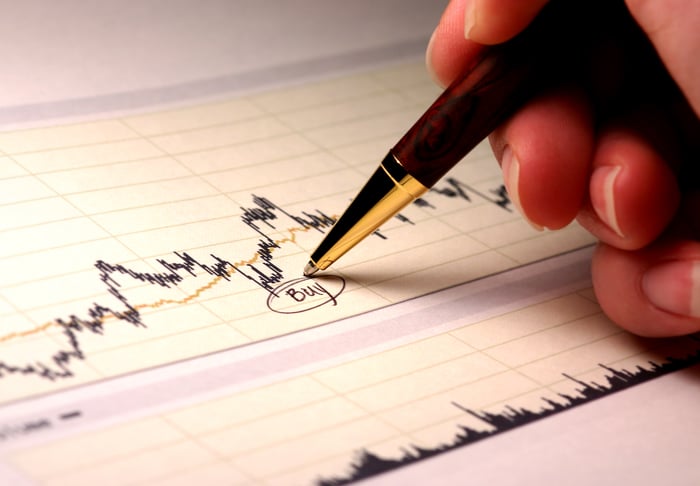Some investors might not be thrilled with what I'm about to say, but it's simply a matter of allowing historical data do the talking: A stock market crash or correction may be brewing.
Recently, the benchmark S&P 500 (^GSPC 0.44%) underwent its first correction of at least 5% in 10 months. While nothing is guaranteed on Wall Street, a number of signs appear to be pointing to the growing likelihood of downside for the broader market.

Image source: Getty Images.
There are a laundry list of catalysts that could send the market lower
For instance, since the beginning of 1950, there have been 38 double-digit percentage declines in the S&P 500. That equates to one drop of at least 10%, on average, every 1.87 years. We're now more than 1.5 years removed from the chaotic bear market decline that bottomed out during the initial stages of the coronavirus pandemic.
To build on this point, the broader market has responded very similarly following crashes or corrections for the past 60 years. Following each of the previous eight bear markets, excluding the coronavirus crash, there were either one or two declines of 10% in the S&P 500 within three years. What this tells us is that rebounding from a bear market is a process and pretty much never the straight line higher that investors have reveled in for more than 18 months.
Macroeconomic factors and fundamental metrics pose warnings, too. Rapidly rising crude oil and natural-gas prices threaten pocketbooks and could quickly throttle down economic growth following the pandemic-induced recession.
There's also margin debt, which has climbed at a precipitous pace in 2021. Data from market-analytics company Yardeni Research shows that there have only been three instances since the beginning of 1995 where margin debt rose 60% or more in a single year. The previous two occurred just months before the dot-com bubble burst and the financial crisis began.
Even valuations are a concern. The S&P 500's Shiller price-to-earnings (P/E) ratio sits at 37.7, which is well over double its 151-year average of 16.9. Perhaps more worrisome, the S&P 500's Shiller P/E has only crossed above and held 30 on five occasions in 151 years. The previous four instances saw minimum declines of at least 20% after the Shiller P/E ratio peaked.

Image source: Getty Images.
Crashes and corrections are an opportunity to buy great stocks at a discount
But there's another side to this story. Even though stock market corrections occur often, they've always eventually been erased by a bull-market rally. Buying great companies at a discount during a crash or correction and holding those stakes for long periods of time is a recipe to build wealth over time.
If a stock market crash or double-digit percentage correction does materialize from this recent uptick in volatility, the following four unstoppable stocks would make for perfect buys.
Berkshire Hathaway
One of the safest ways to build wealth over the long run is to follow in the footsteps of billionaire investor Warren Buffett. The easiest way to do that is to buy shares of Berkshire Hathaway (BRK.A 1.10%) (BRK.B 1.18%), the conglomerate run by Buffett that's averaged a jaw-dropping annual return of 20% since the beginning of 1965 (an aggregate return of close to 3,300,000%).
Berkshire Hathaway's portfolio is successful for two key reasons. First, it's highly cyclical, with about 85% of the company's invested assets tied up in tech stocks, financial stocks, and consumer staples. Though the Oracle of Omaha is fully aware that recessions are an inevitable part of the economic cycle, he also understands that economic downturns don't last very long. He's positioned Berkshire's investment portfolio to take advantage of multiyear periods of expansion.
The other catalyst working in the company's favor is its dividend income. Over the next 12 months, Berkshire Hathaway should collect more than $5 billion in common and preferred dividends, which equates to about a 5% yield, relative to the company's cost basis on its investments. Warren Buffett has demonstrated how easy it is to build wealth on Wall Street by purchasing businesses with clear-cut competitive advantages and not selling.

Image source: Getty Images.
Trulieve Cannabis
If growth stocks are more your thing, marijuana stock Trulieve Cannabis (TCNNF -0.85%) has the look of an unstoppable buy if a crash or correction strikes.
First of all, we witnessed during the pandemic that cannabis is treated as a non-discretionary good. In other words, people kept buying pot products, no matter how badly the pandemic altered the economic landscape in North America.
More specific to Trulieve, it's really differentiated itself from other pot stocks. With most multistate operators (MSOs) setting up shop in well over a dozen legalized U.S. markets, Trulieve focused most of its attention on medical marijuana-legal Florida. Trulieve has 94 operating dispensaries in the Sunshine State, which represents about a quarter of all cannabis retail locations statewide.
Saturating one of the largest pot markets in the U.S. has helped the company effectively build up its brand without breaking the bank on the marketing front. As a result, Trulieve Cannabis has been profitable for more than three years.
What's more, Trulieve recently completed its all-share acquisition of MSO Harvest Health & Recreation. This deal moves it into new markets, and most importantly, makes it the key player in Arizona, which legalized recreational marijuana in November 2020.

Image source: Getty Images.
Viatris
Want deep-discount value and a market-topping dividend yield? Drug-company Viatris (VTRS 0.63%) and its 3.2% yield may well be the unstoppable stock to buy if there's a stock market crash or correction.
Viatris was officially formed less than a year ago by combining Pfizer's established drug unit UpJohn with generic-drug company Mylan. The idea was that the combined entity would be stronger than the two individual units would have ever been.
As you might imagine, combining two drug juggernauts should yield significant efficiencies. The expectation is for more than $1 billion in annual cost synergies by 2023. Further, Viatris' management team expects to have whittled down the company's debt load from $26 billion, when the combination closed, to $19.5 billion by the end of 2023. Less debt outstanding means more financial flexibility and, potentially, the ability to reignite the company's internal research engine.
The real beauty of Viatris is the consistency of demand for its products. Since healthcare stocks are highly defensive, a poorly performing stock market won't change the fact that people need prescribed drugs. Viatris' leading generic division is also perfectly positioned to take advantage of an aging U.S. and global population.
With a forward-year P/E ratio below 4, Viatris has about as a cheap of a multiple as you'll ever see in the healthcare space.

Image source: Getty Images.
Sea Limited
A fourth unstoppable stock to gobble up if there's a stock market crash or correction is Singapore-based Sea Limited (SE 2.64%). Sea has three exceptionally fast-growing operating segments that could one day push its valuation to $1 trillion.
First, there's its digital-entertainment segment, which primarily encompasses mobile gaming. Sea ended June with 725 million quarterly active users, 12.7% of which (92.2 million) were paying to play. The average pay-to-play ratio throughout the gaming industry is closer to 2%. Additionally, average bookings per user rose to $1.60 in Q2 from $1.40 in the prior-year period. For the time being, this is the only segment generating positive earnings before interest, taxes, depreciation, and amortization (EBITDA).
Second, Sea has its rapidly growing e-commerce platform, known as Shopee. In the latest quarter, Shopee handled 1.4 billion gross orders (up 127% year over year) and $15 billion in gross merchandise value (GMV). For some context, Shopee handled $10 billion in GMV in the entirety of 2018. The company's annual online retail run rate has sextupled in 2.5 years.
Lastly, its digital financial services segment has 32.7 million paying digital-wallet users and oversaw more than $4.1 billion in payments in the June-ended quarter. Since many of the emerging markets Sea serves are underbanked, digital wallets could be a sneaky long-term growth story for the company.





